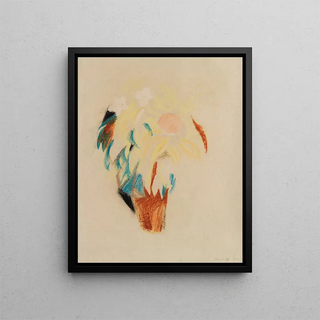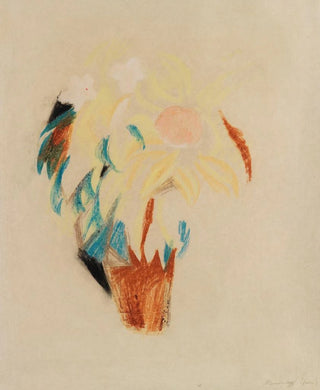Painting Large flower pot - August Macke | Art print


View from behind

Frame (optional)
In the vibrant world of modern art, the artwork "Grand pot de fleurs" by August Macke stands out for its liveliness and bold use of color. Painted in 1914, this canvas evokes joy of living and the beauty of nature through a harmonious and dynamic composition. Macke, an iconic figure of the expressionist movement, manages to capture the very essence of blooming, inviting viewers to immerse themselves in a world where color and light meet with rare intensity. The art print of "Grand pot de fleurs" by August Macke allows for rediscovering this masterpiece, a true ode to nature and wonder.
Style and uniqueness of the work
Macke's style is characterized by a vibrant palette and simplified forms, reflecting a constant pursuit of harmony. "Grand pot de fleurs" is no exception to this rule. The flowers, with their bright and varied hues, flourish in a balanced composition, where each element seems to vibrate with its own energy. The artist employs broad, expressive brushstrokes, giving the piece an almost tactile dimension. This approach, blending abstraction and representation, invites active contemplation, where the viewer's eye is drawn into a play of colors and textures. Macke succeeds in creating a joyful and light atmosphere, where everyday life transforms into a living tableau, a moment suspended in time.
The artist and his influence
August Macke, a member of the expressionist group Der Blaue Reiter, left his mark on his era with an innovative vision of art. Influenced by contemporaries such as Kandinsky and Marc, he developed a unique style that combines sensitivity with experimentation. His ability to translate complex emotions through simple, colorful compositions made him a pioneer in modern art. Macke was also inspired by his travels, notably in Tunisia, where he discovered landscapes and cultures that enriched his work. His artistic vision, blending abstraction and figuration, continues to influence many contemporary artists, demonstrating the modernity of his approach and the timelessness of his creations.

Matte finish

View from behind

Frame (optional)
In the vibrant world of modern art, the artwork "Grand pot de fleurs" by August Macke stands out for its liveliness and bold use of color. Painted in 1914, this canvas evokes joy of living and the beauty of nature through a harmonious and dynamic composition. Macke, an iconic figure of the expressionist movement, manages to capture the very essence of blooming, inviting viewers to immerse themselves in a world where color and light meet with rare intensity. The art print of "Grand pot de fleurs" by August Macke allows for rediscovering this masterpiece, a true ode to nature and wonder.
Style and uniqueness of the work
Macke's style is characterized by a vibrant palette and simplified forms, reflecting a constant pursuit of harmony. "Grand pot de fleurs" is no exception to this rule. The flowers, with their bright and varied hues, flourish in a balanced composition, where each element seems to vibrate with its own energy. The artist employs broad, expressive brushstrokes, giving the piece an almost tactile dimension. This approach, blending abstraction and representation, invites active contemplation, where the viewer's eye is drawn into a play of colors and textures. Macke succeeds in creating a joyful and light atmosphere, where everyday life transforms into a living tableau, a moment suspended in time.
The artist and his influence
August Macke, a member of the expressionist group Der Blaue Reiter, left his mark on his era with an innovative vision of art. Influenced by contemporaries such as Kandinsky and Marc, he developed a unique style that combines sensitivity with experimentation. His ability to translate complex emotions through simple, colorful compositions made him a pioneer in modern art. Macke was also inspired by his travels, notably in Tunisia, where he discovered landscapes and cultures that enriched his work. His artistic vision, blending abstraction and figuration, continues to influence many contemporary artists, demonstrating the modernity of his approach and the timelessness of his creations.
12,34 €






